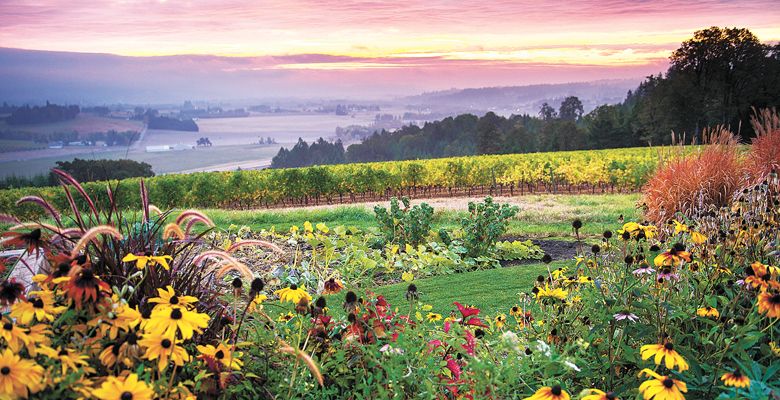ALIVE and Well
LIVE meets to discuss sustainability efforts
By Mark Stock
On April 17, LIVE members gathered at the Chehalem Cultural Center in Newberg for the organization’s annual meeting, which included membership and vineyard reports, partner and research updates, as well as a few keynote speakers, featuring Leda Garside of ¡Salud! Services and prominent wine writer Jon Bonné.
LIVE was established in 1999 and is a regional organization promoting sustainable winegrowing practices. As was revealed at the gathering, membership is up to 319 vineyards and 35 wineries in the state of Oregon alone, with additional members spanning Washington and Idaho. More than 9,500 acres of LIVE-certified vine acreage exists in state. The movement is popular even in brand new AVAs like the Van Duzer Corridor. There, 10 of the 17 vineyards within the appellation are certified and follow LIVE protocol.
Organization members outlined several new projects in the works, including the creation of a biodiversity checklist in conjunction with Oregon State University, the carbon footprint of glass use and courses on beekeeping, weed management and beneficial birds. LIVE is also involved in a Buzz Box Outreach Project, which brings native flora to vineyard sites with the hopes of creating a corridor between the vineyard and the natural habitat.
A big part of LIVE’s growth beyond Oregon is thanks to the outreach of Brighid O’Keane. She’s engaged in more than 100 vineyard and winery visits in the Evergreen State and continues to partner with institutions such as Washington State University, Walla Walla Community College and Yakima Valley College. Her work involves certification training as well as education. She is a big reason why Washington is up to 23 vineyards and seven wineries certified by LIVE.
LIVE depends mightily on research, and the board offered a promising glimpse of these efforts. Chemeketa Community College is unveiling a new enticement this May in the Al MacDonald LIVE Wine Studies Scholarship for first-generation students taking part in the school’s wine studies program. Chris Serra, LIVE’s executive director, has been working on a greenhouse gas calculator for vineyards, something a host of producers have already agreed to test.
A project approved by LIVE in 2017 continues to make headway. The biodiversity tool launched by Matt Shinderman of Oregon State University, when finished, will help participating vineyard and wineries identify and encourage a broad range of native species to co-inhabit their estates. More positive news came from partner organization Salmon-Safe, an eco-label consumers seem to be increasingly seeking out. The organization is expanding beyond the wine realm to farming in general, recruiting fruit growers and encouraging them to adopt watershed-sensitive farming approaches.
Awards were handed out to Kelli Gregory of Adelsheim Vineyard, and Lisa and Gene Bennett of Bennett Vineyards. The decoration acknowledges excellence in the realm of sustainability. In addition to the re-election of four current board members (Leigh Bartholomew, Luisa Ponzi, Jessica Sandrock, Dr. Russell Smithyman), a new member was welcomed: Deb Hatcher, co-founder of A to Z Wineworks.
After LIVE finished sharing its annual reporting and organizational bullet points, several speakers offered brief presentations. The content was wide-ranging and timely, given both the current socio-political climate and the wine industry’s growing pains.
Garside discussed wellness in the industry, highlighting the importance of a healthy workforce via safe labor environments and insurance plans or programs that make sense to all parties involved. As clinical services manager of OHSU Tuality Healthcare, Garside is in the vineyards often, providing outreach on healthcare to field workers especially. She talked candidly about the increasing stress levels she’s encountered among Oregon vineyard workers, living in fear amid a political climate that’s proven anything but inclusive.
Author, journalist and wine writer Jon Bonné tackled what felt like the elephant in the room: the very meaning of sustainability. The term, he suggests, has been manipulated by mass media and exploited by larger producers, resulting in a lot of consumer confusion. “LIVE is about as close as you’ll get to a gold standard for sustainability,” he says. Bonné offered the organization in the same breath as other notable like-minded groups, such as Fair ‘n Green in Germany and LODI RULES in California. “Sustainability is facing the same challenges as the word ‘natural,’” he continues. In other words, the term has become devalued or misleading to the point of not really informing at all.
The writer’s hour-long presentation was a sobering reminder that while everybody in that room was virtuously pushing for holistic, environmentally friendly standards in winegrowing, organizations like LIVE aren’t exactly being embraced by the larger sectors of the American wine machine. But it’s certainly not going away, as the growth of the organization suggests and the increasing consumer urge to know increasingly more about what they’re ingesting, whether it’s a head of lettuce or a glass of Riesling. The hard part, at least from a wine sustainability standpoint, is selling a practice that’s essentially still being defined.
The next generation of the wine industry ought to be inspired — and activated — by how much LIVE has accomplished in a mere two-decade span. Oregon may still only occupy a small slice of the domestic wine pie chart, but it’s eating up increasingly more press space, critical acclaim and attention, in general. Leading by example, is always a good approach.
“If you are doing good work,” Bonné’s final Powerpoint-projected sentiment read, “talk about it.”










